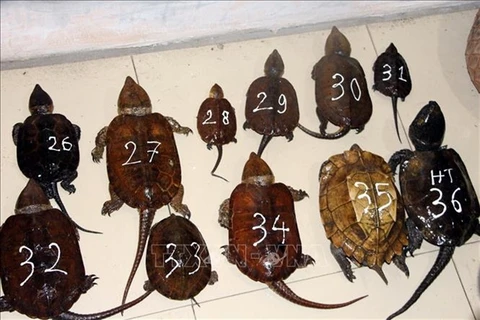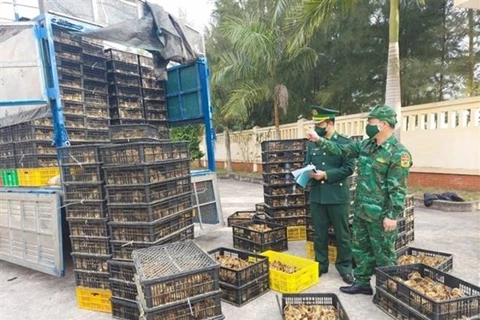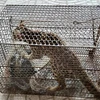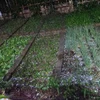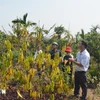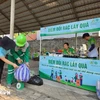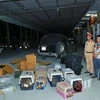Hanoi (VNA) – Many zoos or farms in Laos have registered to take care of tigers. However, it seems they are raising the endangered animals for illegal butchering for bones, meat and other body parts.
VietnamPlus reporters went behind the scenes traveling to several hot spots implicated in the illegal trade of wild animals, especially those listed in the Vietnam Red Book, from Laos to Vietnam.
AB, a wildlife expert at a university in Laos accompanied us on the trip, and said that around 500 tigers were held captive in Laos 3-5 years ago. However, the number has dwindled significantly now.
Before 2015, illegal trade of tigers was vibrant in Laos, with many people from the central provinces of Ha Tinh and Nghe An engaging in the making of tiger bone glue, according to AB.
In Thakhek, Xiengkhouang and Bolikhamsai, tigers were sold right at the farms. Staff at several farms in Phong Pheng village, Khamkeut district, Bolikhamsai province even showed visitors the process of making tiger bone paste.
Seeing an array of rare animals on the brink of extinction, the forest management authority of Laos has tightened management to prevent illegal trade of wilde animals. The public cooking of tiger bone paste, therefore, is illegal.
Most of the tiger farms have moved to operate under a zoo model, AB said, adding they now open doors for visitors to gain revenue for tiger care and preservation work.
“However, tiger bone glue is made secretly under agreements and contracts,” he said.
Coming to a tiger zoo located on a upper hill within Numthurn Resort in Bolikhamsai province, we found that none of the 30 tigers held captive in small cages had long to live. Some were lying on the floor and some were pacing back and forth aimlessly, behind bars. They all groaned mournfully when seeing strangers, and there was a tiger rushing and repeatedly crashing into the fence of its cage.
The manager from the zoo said Vietnamese customers regularly come to buy tigers and then sell them to the Chinese market.
Each tiger is traded at around 100,000 USD under contract, he said.
We then left for Khammoune tiger farm, a hot spot for tiger bone paste making, according to AB. The facility was converted into a zoo after facing mounting pressure from international organisations for animal conservation as well as drastic measures from the Lao Government.
A leader of a national park in Laos said that Khammoune Zoo is among one of the largest tiger conservation facilities in Laos, home to some 50 animals.
Every month, the zoo has to spend a large amount of money purchasing chicken from Thailand to feed the tigers. With the entrance fee of only 20,000 LAK (0.96 USD), it is impossible for the zoo to cover maintenance costs and staff payment, especially since not many tourists come to the zoo.
Actually, there were no visitors to the zoo on May 24, but 8-10 staff were bus feeding the tigers.
So we raised a question whether Khammoune continues selling tiger bone paste as was the practice years ago. The ticket seller at the zoo said “No” but the answer came while we had lunch at a restaurant in Salavan province, more than 60 kilometres from Khammoune Zoo.
Lan – the owner of the restaurant from Huong Khe district, Ha Tinh province spilled the beans about the godfather of tiger bone paste – the manager of Khammoune Zoo.
“We make tiger bone paste. There is one container of paste in the refrigerator, do you want to buy it?”, Lan said.
“It costs 20 million VND per gram. The quality is guaranteed. It took my son seven days, and six nights to cook up the concoction.”
We deliberately expressed interest in the paste, and asked further about its origin.
Lan said the tiger was bought from a tiger zoo owned by a man called Luom in Khammoune. Her family leased his land to open this restaurant.
Getting Luom’s phone number from Lan, we left the restaurant to find the godfather. We told Lan that we were going to Vientiane and would come back if we found “real” tiger paste.
We then called Luom, who spoke in Laotian and cautiously asked who gave us his phone number. He started to open up when we said we got it from Lan. However, he kept insisting that he raises tigers at the zoo for the purpose of preservation, not trading tiger bone glue.
In another phone call with Lan, we were informed that Luom transported tigers to L and V – Lan’s relatives for slaughter. He also made tiger bone glue. She sent us a piece of glue taken from the refrigerator, and a video clip recording a group of people cooking tiger bone paste in a big pot.
We asked Lan whether she sells other products from wild animals, and she said in cheerful voice: “I have a big tortoise shell, pangolin, northern Chinese boar, and bengal monitor.”
“Do you want my tiger bone glue? It was made from Luom’s tiger. Earlier, he sold the whole tiger to a customer in Vietnam.”, she said./.



